
The History of Plac Dworcowy and Piłsudskiego Street – A Tale of Remarkable Transformation
From a forgotten military foreground to the vibrant heart of the city, the story of Plac Dworcowy and Piłsudskiego Street is one of extraordinary change.
Plac Dworcowy is a place with a rich history, closely tied to the development of the railway and urban planning in Wrocław. Once, this area was part of the fortress esplanade – an open space left undeveloped to ensure the city’s defense. It was surrounded by gardens and orchards, and a wide country road called the Świdnicki Wygon ran through its open expanse. Everything changed with the advent of the railway, which forever altered the fate of this area.
Over time, Plac Dworcowy became the city’s main transportation hub and a showcase for travelers. The square has continually evolved to meet the changing needs of the city and advances in technology. In the 19th century, it saw the construction of the first maneuvering square for horse-drawn carriages, later followed by horse trams and eventually electric trams—always ensuring fast and convenient connections to other parts of Wrocław.
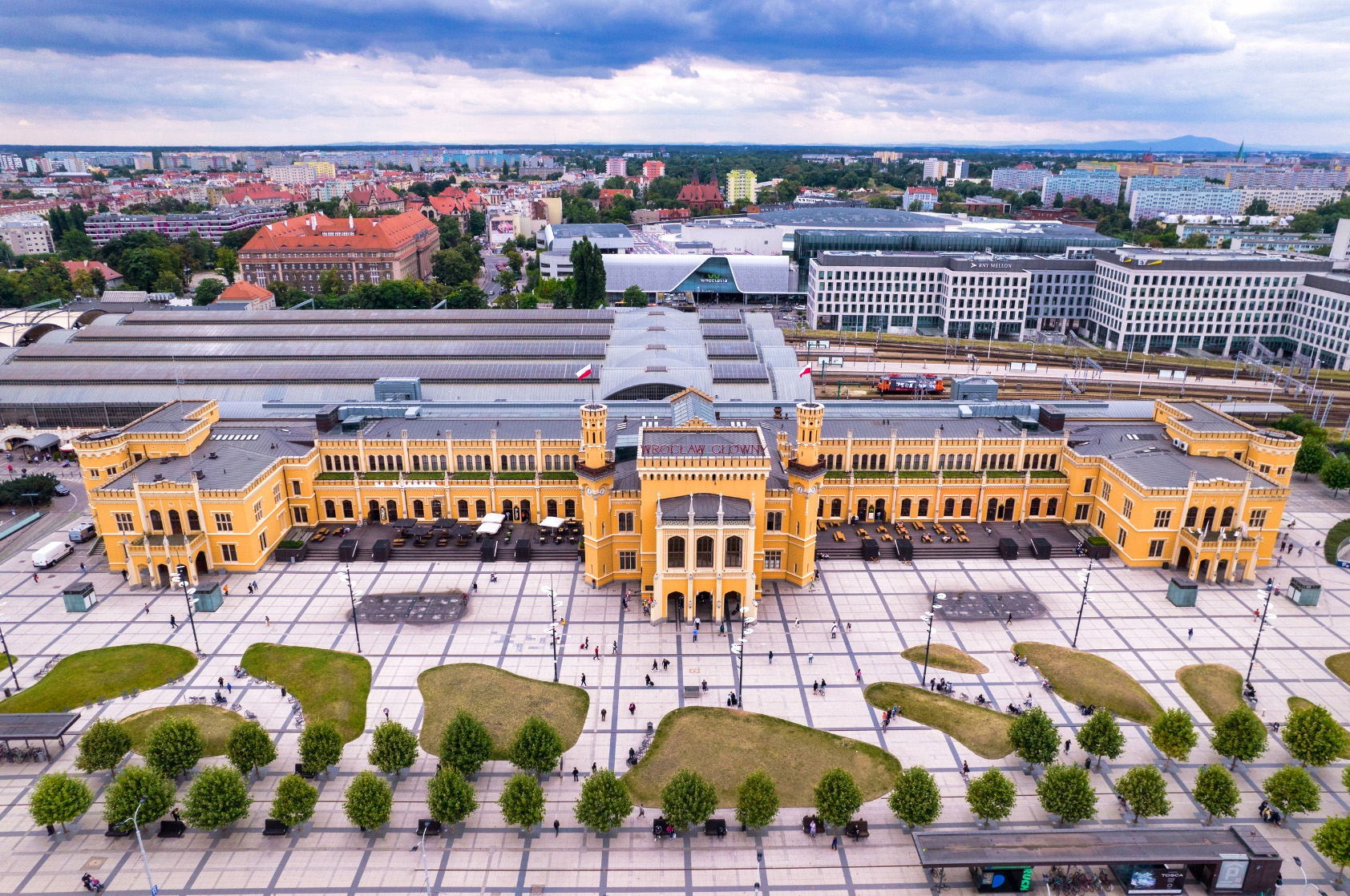
When the first line of the Upper Silesian Railway to Oława opened on May 22, 1842, no one could have foreseen the profound impact the railway would have on the city's future. Just a year later, the Świebodzki Station was built, followed by the Lower Silesian Railway Station in 1844. However, it was the opening of the Main Railway Station on October 27, 1857, that truly sparked a revolution.
Constructed between 1855 and 1857, the building was designed by Wilhelm Grapow and stood out from the beginning with its monumental style inspired by English Gothic. Its distinctive towers, decorative crenellations, and brick façade gave it a palace-like appearance. An interesting fact: a large clock once stood in front of the main entrance, marking the rhythm of daily life for both locals and travelers.
The station also witnessed many historical events — it welcomed important figures within its walls and served as a key evacuation point during World War II.
After the war, Wrocław’s Main Railway Station underwent numerous modernizations, yet its neo-Gothic façade and iconic arcades have endured. In the 21st century, it underwent a thorough renovation, restoring its former glory while adapting it to modern travel standards.

Today, the Main Railway Station and its surroundings still serve as both a symbolic and practical gateway to the city. It is the first place visitors see as they arrive in Wrocław. The revitalization of Plac Dworcowy and the neighboring buildings—including hotels and historic townhouses—has restored the area’s former charm, transforming it into an elegant showcase for the city. The two towers of the neighboring hotels—Mövenpick Grand Hotel Wrocław and Hotel Piast across the street—together form the Gateway to the City.
Hotel Grand – A Wrocław Icon Reborn
Hotel Grand is one of the most renowned and historic hotels in Wrocław. Its roots date back to the 19th century, when it opened in 1903 under the name Hotel du Nord. Even then, the building stood out for its elegance and prestige, attracting guests from across Europe. After World War II, the hotel was renamed Grand Hotel and became one of the most distinguished accommodations in postwar Wrocław.
Over the decades, Hotel Grand welcomed travelers, artists, and prominent figures from the worlds of culture and politics. During the communist era, it symbolized elegance and luxury, with its restaurant enjoying wide acclaim. In later years, the building fell into disrepair and the hotel was closed, awaiting renovation.
Today, the building has been fully restored and reopened in 2025 under the name Mövenpick Grand Hotel Wrocław. Its spectacular historic façade harmonizes perfectly with the stylish Art Nouveau interior of this four-star hotel.
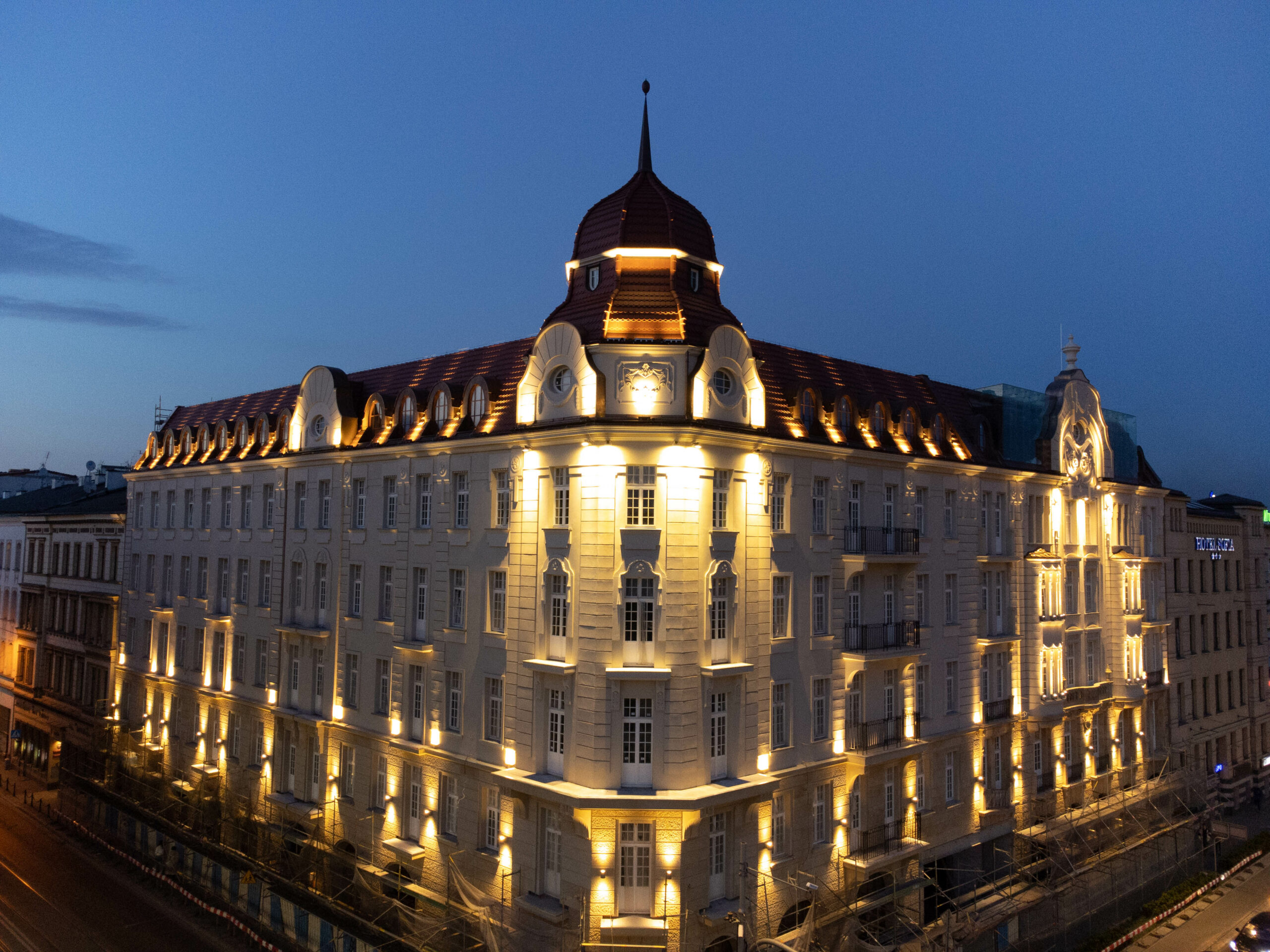


Across from Hotel Grand stands Hotel Piast – one of the most recognizable hotels in Wrocław. The building was constructed in 1908 as Hotel Kronprinz (Hotel of the Crown Prince) and was part of a grand urban development plan for the area surrounding the railway station.
Built in a historicist Art Nouveau style, with its distinctive corner tower and decorative facade, it was a modern and elegant destination for travelers arriving in Breslau. After World War II, the hotel was renamed Hotel Piast, referencing the city’s Piast dynasty heritage.
Today, following a thorough modernization, the three-star Hotel Piast is once again ready to welcome guests, offering comfort and hospitality to travelers.
Piłsudskiego Street is one of the most important and representative thoroughfares in Wrocław, connecting the Main Railway Station with the city center. Its golden era began in the second half of the 19th century. Previously, it had been a country road, dotted with rural houses and lined with gardens—hence its pre-war name, Gartenstrasse (Garden Street), officially introduced in 1823.
By the end of World War II, much of the street’s development had been destroyed. Reconstruction began in the 1950s and 60s, focusing mainly on the northern frontage and the area around what is now Plac Legionów, located slightly further along the street. In 1947, the street was renamed in honor of General Karol Świerczewski, becoming one of the city's main arteries. May Day parades were held here annually. Following political changes, the street was renamed in 1992 after Marshal Józef Piłsudski, whose name it still bears today.
As you stroll along the street, you can admire preserved historic townhouses featuring Art Nouveau architectural elements. The scale, richness of form, and ornate detailing of this style continue to impress with their elegance.

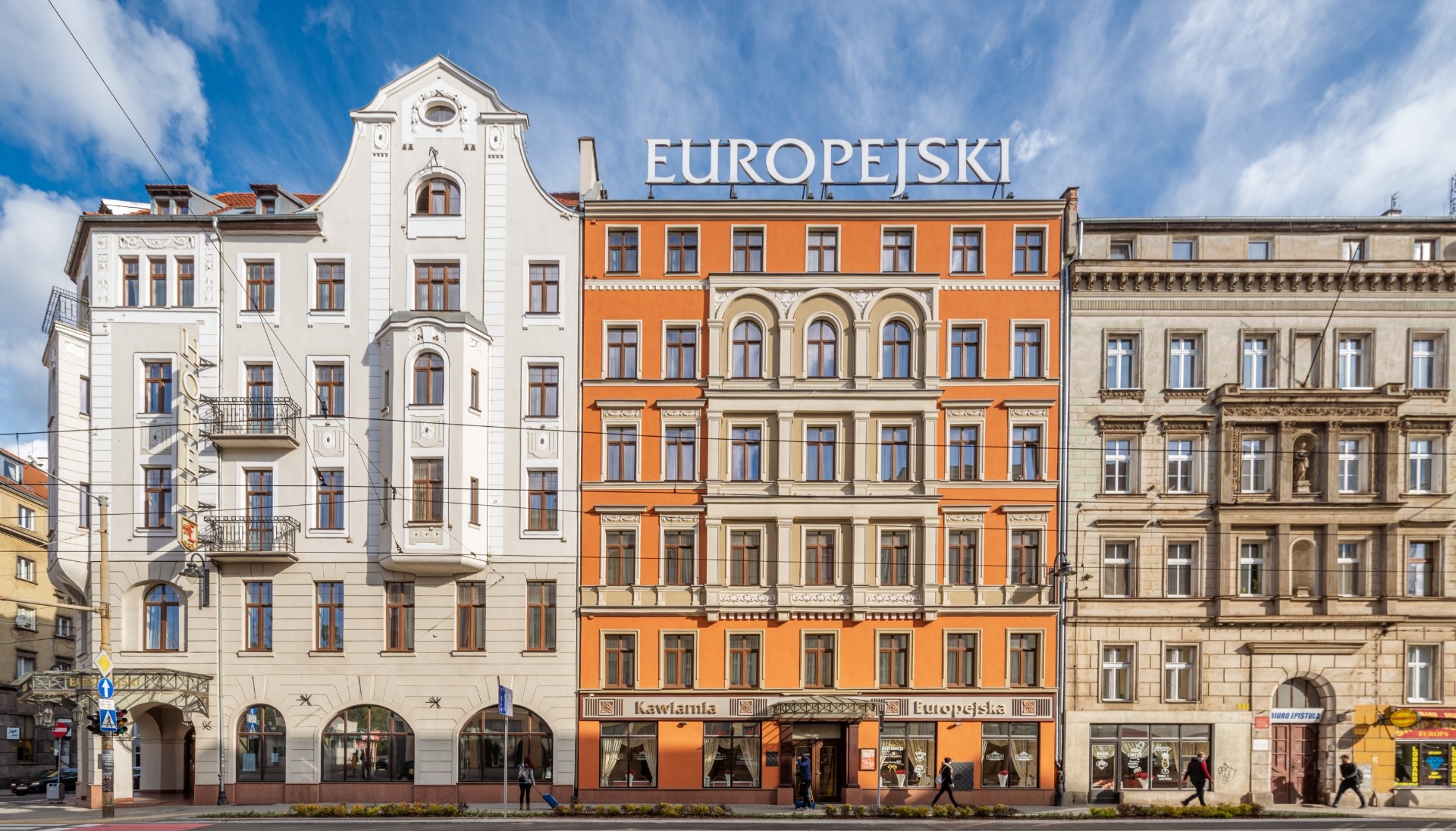
The building of Hotel Europejski deserves special attention as a prime example of elegant Neo-Renaissance architecture with elements of Classicism. The hotel was opened in 1877 under the name Hotel de Sud, and shortly thereafter became known as Hotel Europejski. It quickly gained prestige, becoming one of the most refined hotels in the city.
The stately building retains its historic charm, evident in its symmetrical façade, decorative masks, and rich stucco detailing. Inside, the hotel is preserved in the Belle Époque style. The reception hall features marble floors, a wooden counter, and elegant finishing touches.
Right next door, you'll find the stylish Kawiarnia Europejska – a café in sophisticated Viennese style.
The impressive building on the right – now home to NOT (The Chief Technical Organization) – holds over 130 years of history. It was originally constructed as the seat of the Silesian Parliament. Construction began in 1892 and was funded by the state treasury of the Kingdom of Prussia. The funds came from the war reparations that France was obliged to pay after losing the Franco-Prussian War (1870–1871).
The building was designed by building counselor Eduard Blümner, with sculptural details on the facade created by Christian Behrens and Ernst Seger. Particularly eye-catching are two Atlas figures – the elder representing the Past, and the younger symbolizing the Present.
In 1896, the building hosted Tsar Nicholas II and his wife during their visit to Wrocław. After the war, the structure underwent numerous renovations and, since 1946, has served as the headquarters for engineers and scientists of the Chief Technical Organization (NOT).
Listed as a historical monument in 1977, the building continues to impress with its architectural details – especially the ornate entrance portal featuring a cartouche with the Silesian coat of arms, the St. Jadwiga Hall, and the Aula with its stunning skylight.
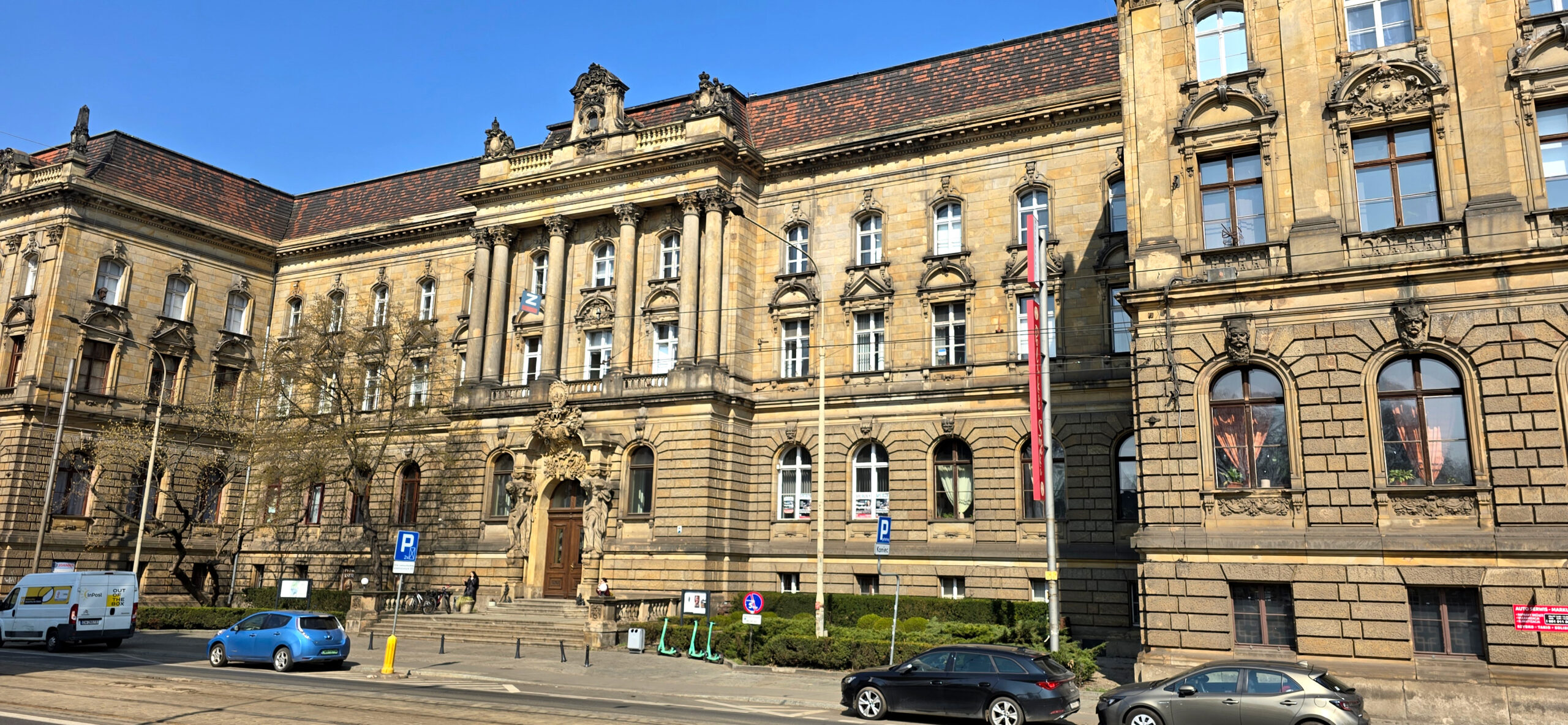
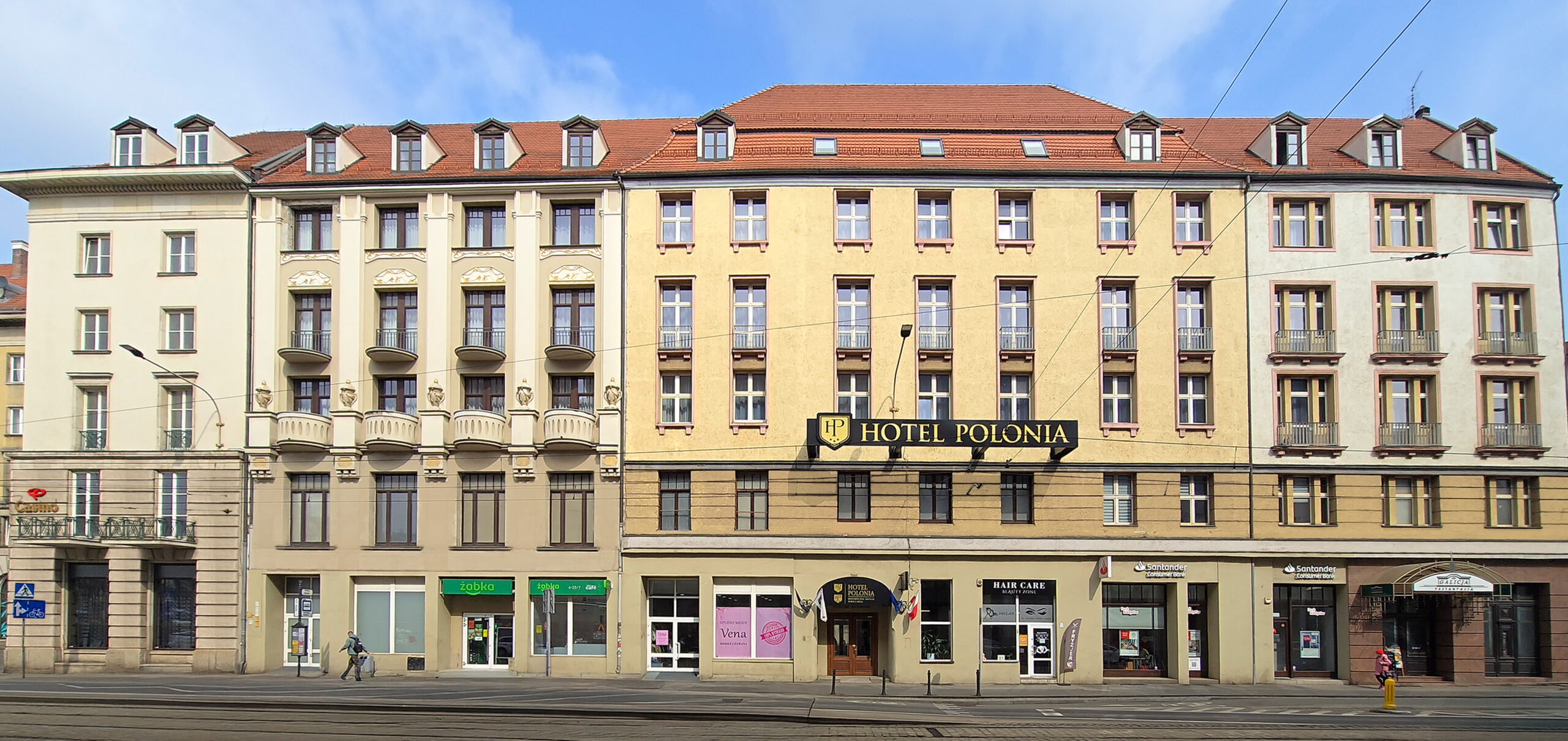
Continuing along Piłsudskiego Street, on the right-hand side you'll see Hotel Polonia – formerly the luxurious Hotel Vier Jahreszeiten (Four Seasons), built in 1911. The building was modernized in 1939, and for over forty years it has been known by its current name, earning recognition and affection from its loyal guests.
The hotel has preserved its impressive façade and historical atmosphere. Just nearby, you’ll also find Restauracja Galicja, whose remarkable interiors are inspired by the style of the Austro-Hungarian Empire era.
Just a few steps further, it’s impossible to miss the Capitol Musical Theatre. This extraordinary institution, operating in the heart of the city, boasts nearly a century of history—one filled with both turbulent and fascinating chapters.
The Capitol was built in 1929 as one of the most beautiful modernist buildings in Europe. Originally designed as a cinema-theatre, it quickly became a place where locals enjoyed music and the magic of film. Unfortunately, the ravages of war left the building heavily damaged. After its reconstruction, it became home to the Wrocław Operetta and the Śląsk cinema, attracting generations of art enthusiasts. Today, it is one of the most modern musical theatres in Poland. Thanks to multiple renovations and expansions, it now seamlessly blends past and present.
The building's geometric form, impressive in its monumental scale, reflects the spirit of modernism—clean lines, minimal ornamentation, and architectural clarity. Inside, the theatre houses elegant, classically styled spaces. Be sure to step into the so-called Capitol Courtyard—a glass-roofed area that serves as an open zone for gatherings and cultural events.
During the modernisation process, great care was taken to preserve original details from the 1920s, which can still be seen in sections of mosaic, ornate railings, and the stylish foyer. The main auditorium impresses with its spaciousness, muted color palette, and gentle lighting. The amphitheater-style seating evokes the atmosphere of the original cinema-theatre, bridging a storied past with a vibrant present.
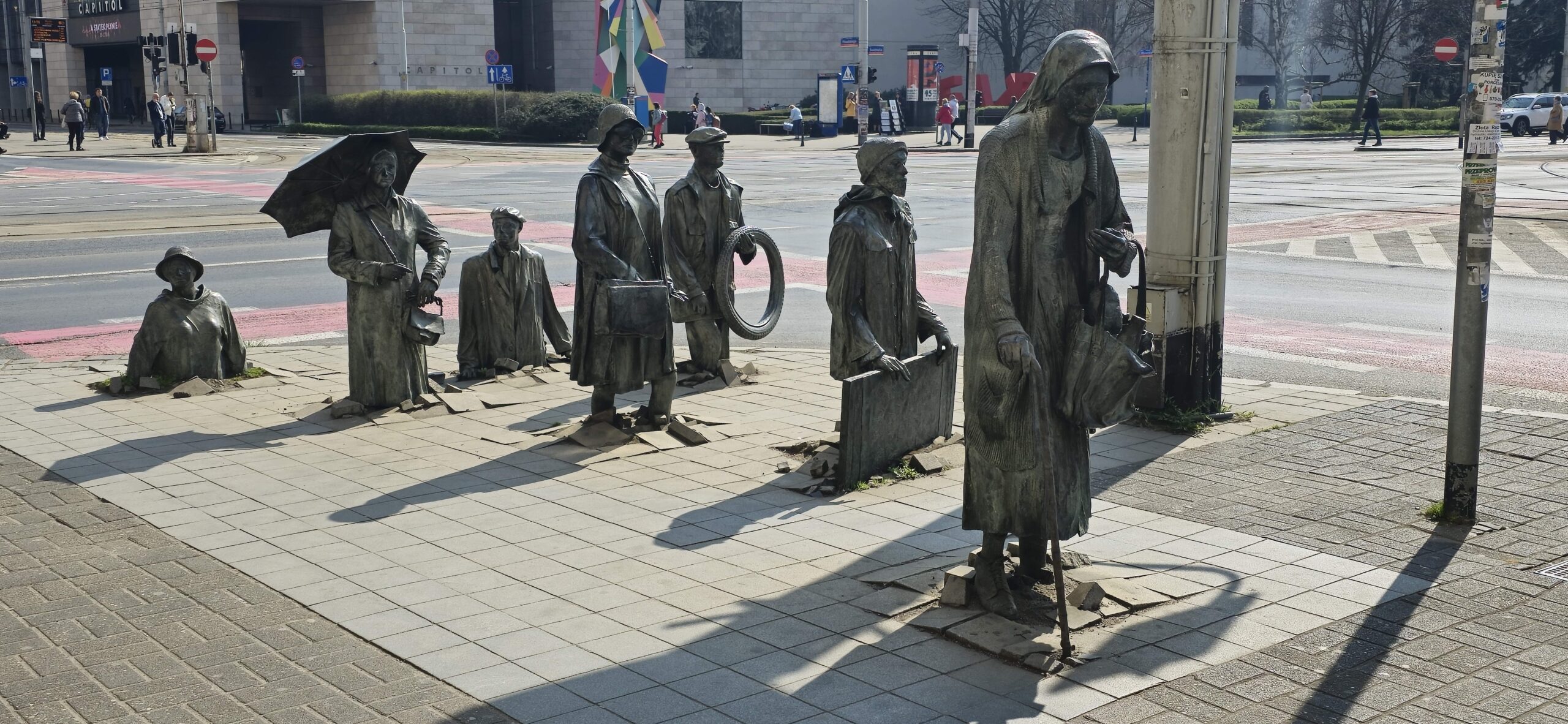
Turning right onto Świdnicka Street—one of the most iconic and historic streets in Wrocław—you follow what was once part of a major trade route from Wrocław to Świdnica, from which the street takes its name. Since the 13th century, this road has served as an important urban axis, linking the Market Square with the Świdnicka Gate in the city walls.
Today, Świdnicka Street is not only a popular spot for strolling, shopping, and socializing, but also a vibrant cultural space filled with galleries, theaters, and artistic installations—most notably, the Monument of the Anonymous Passerby. These life-sized bronze figures, which appear to sink into the pavement on one side of the street and rise again on the other, evoke emotion and provoke reflection. This extraordinary piece of urban art captures the imagination of visitors from around the world.
Continuing your walk along Świdnicka Street, you arrive at the elegant structure of Renoma – formerly the Wertheim department store. Built in 1930, it was once the largest and most modern shopping center in Wrocław. After the war, known as "Pedet", it became one of the city's most important retail destinations. In 1977, the building received official recognition when it was listed as a historic monument, celebrated as an example of European modernism.
Today, Renoma once again impresses with its modernist form and meticulously restored interior. Two grand atriums have been recreated, and the spaces are illuminated by striking chandeliers made of ribbed glass, inspired by the original 1930s designs. The interior finishes include marble imported from Turkey and Portugal, whose varied textures add a dynamic character to the space.
One of the most intriguing features is the decoration of the skylight walls—adorned with sculpted heads inspired by those that once graced the façade of the original Wertheim building. These replicas were crafted by Wrocław artist Pola Ziemba, paying homage to the building’s rich and layered history.
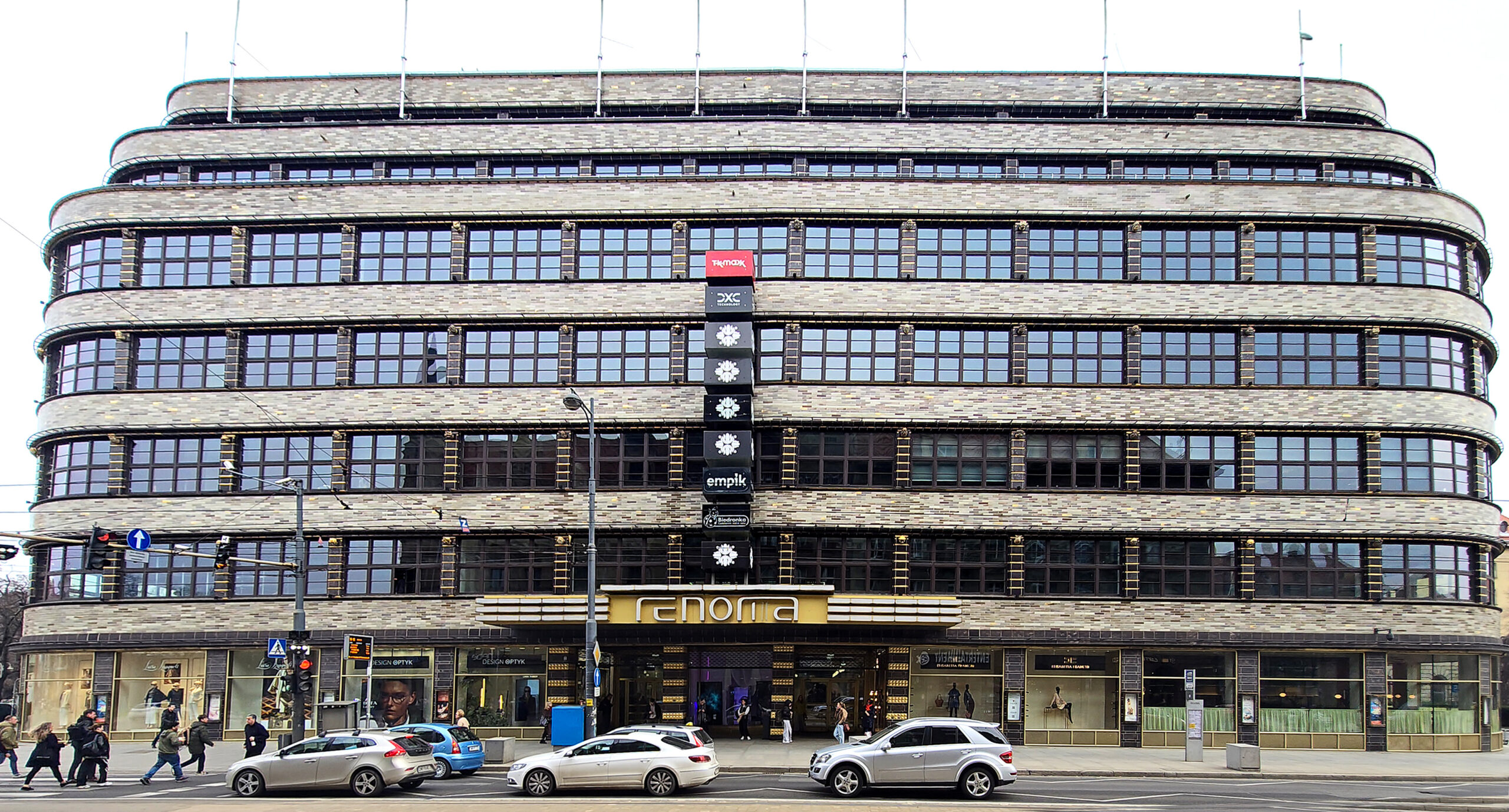
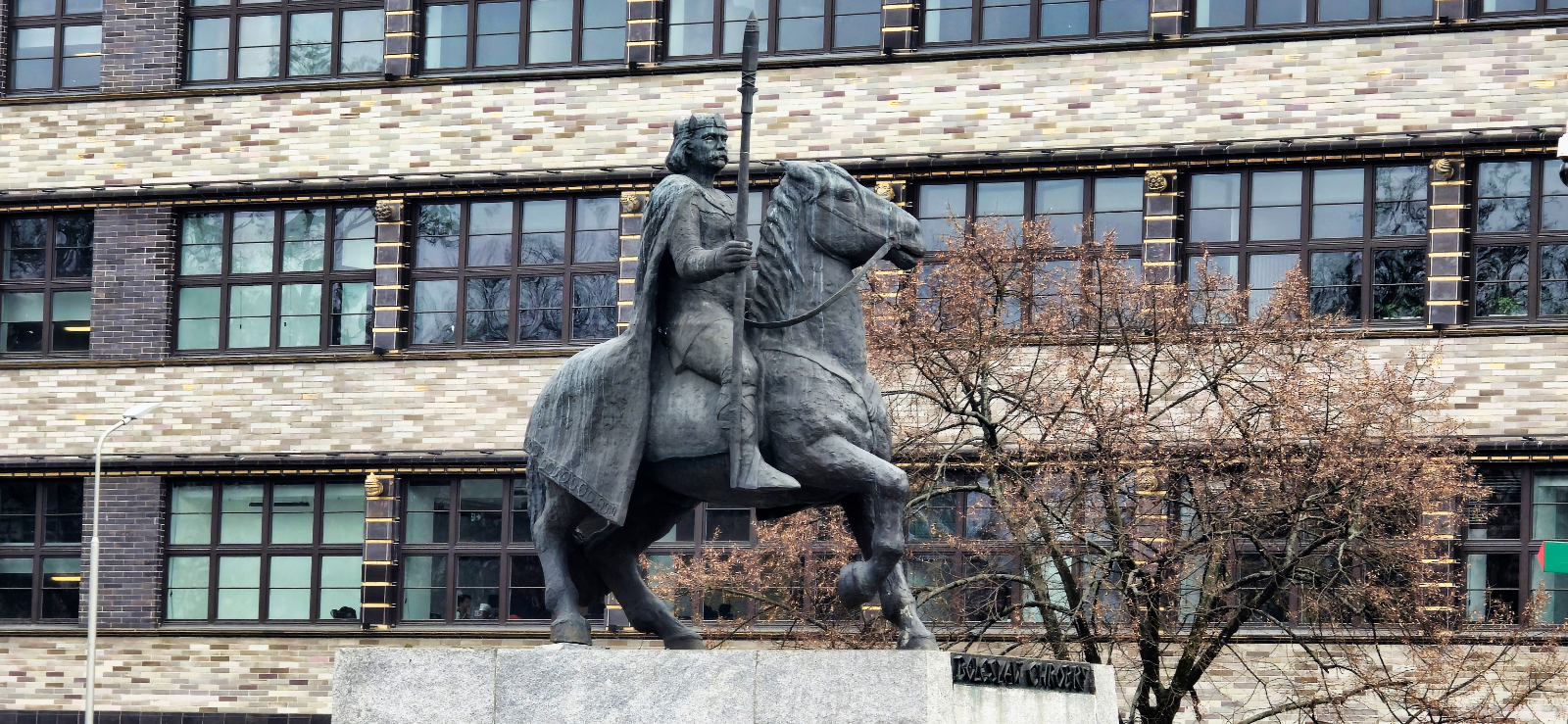
Nestled in the shade of the trees stands the Monument to the King Bolesław Chrobry —a monumental sculpture of Poland’s first king, holding the Spear of St. Maurice. The statue serves as a symbolic tribute to the city’s history and its role in the formation of the Polish state.
The figure is adorned with a ribbon inscribed in three languages—Polish, Czech, and German—highlighting Wrocław’s multicultural heritage. The monument stands precisely where a statue of Emperor Wilhelm I once stood, creating a symbolic link to the city’s shifting historical narrative.
A bit further up Świdnicka Street, the majestic silhouette of the Wrocław Opera comes into view—a true jewel among the city’s historic landmarks and one of its most important cultural institutions. Even from a distance, the building captures attention with its elegance and harmonious proportions—an excellent example of neoclassical architecture that blends geometric simplicity with monumental grandeur.
Constructed between 1839 and 1841 to the design of Carl Ferdinand Langhans, the Wrocław Opera was a symbol of the city’s cultural prestige from the very beginning. After fires in 1865 and 1871, the building underwent significant reconstruction under architects Karl Lüdecke and Karl Schmidt. The auditorium was raised, the stage expanded, and the façade was given a more imposing, representative character. Statues of the Muses appeared on the roof—today replaced by modern replicas of the lost originals.
Inside, the opera house dazzles with gilded details, monumental ceiling paintings, and crystal mirrors, preserving the elegance and atmosphere of 19th-century sophistication.
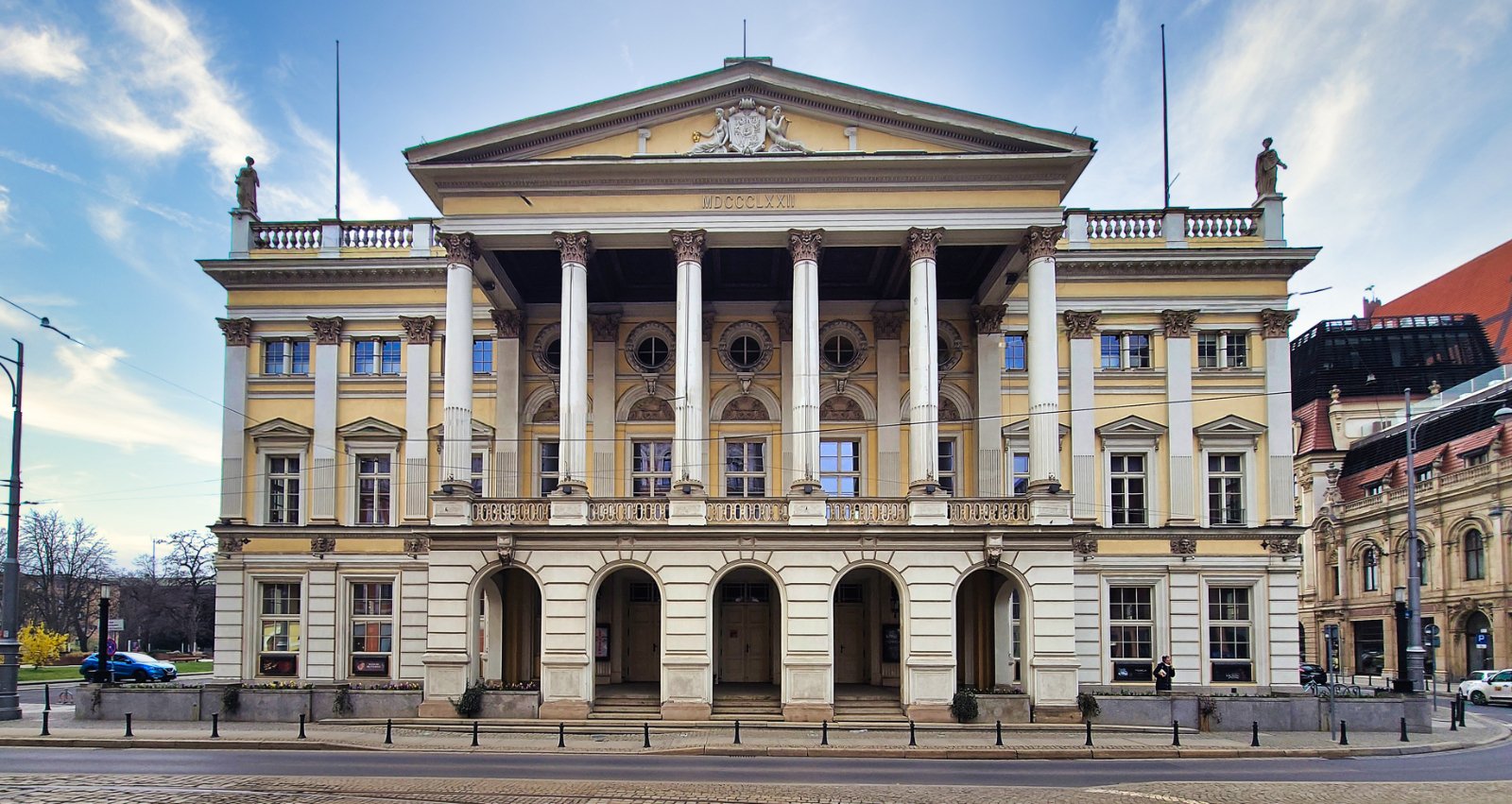
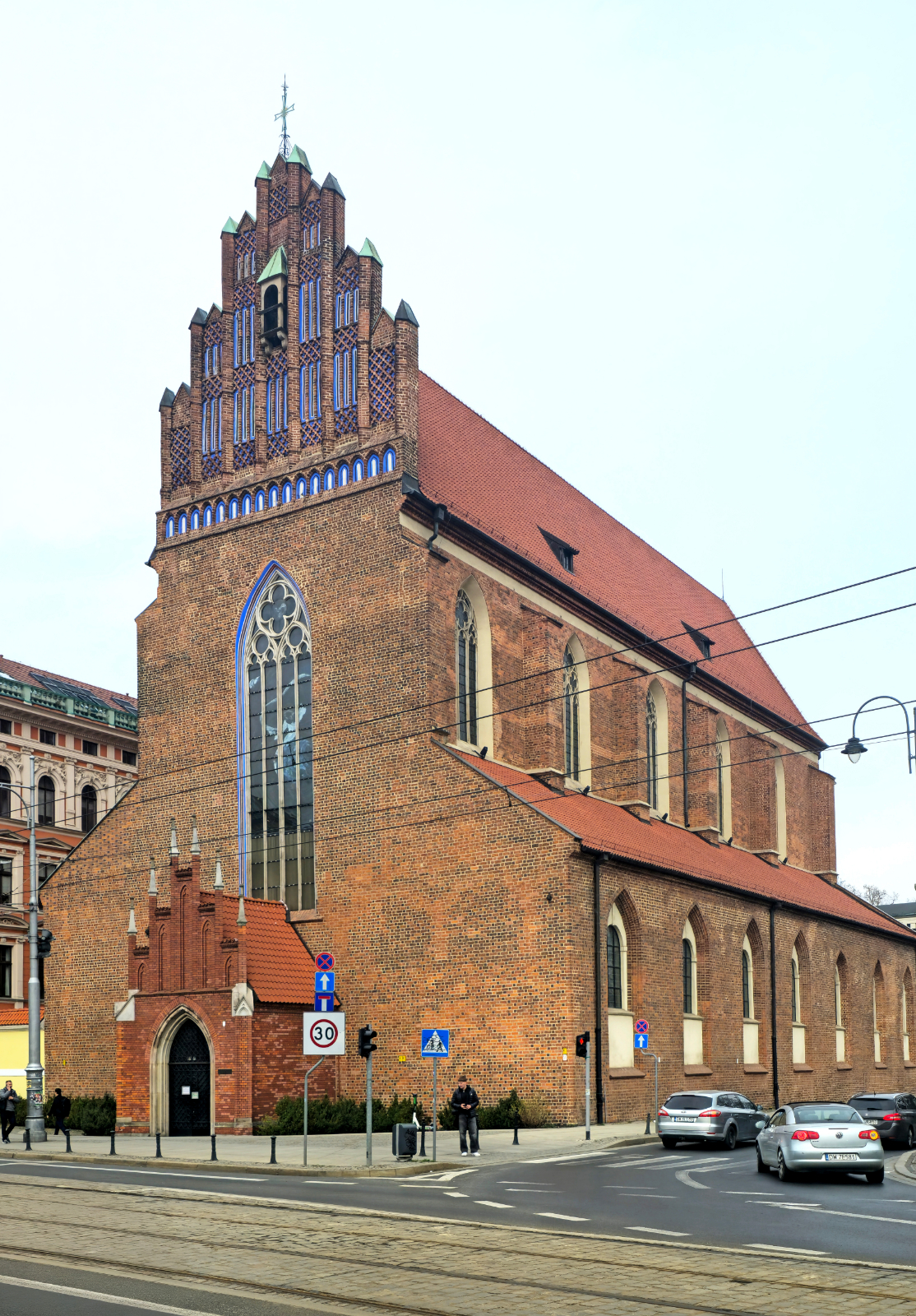
Continuing the walk along Świdnicka Street, we come upon of the “Bożego Ciała” Church —a monumental brick temple that has been part of Wrocław’s historic landscape for centuries. Its origins date back to 1318, when it was founded by the Knights Hospitaller—a medieval military order now known as the Knights of Malta. The church’s Gothic brick silhouette evokes the atmosphere of a medieval city and remains one of Wrocław’s most valuable sacred landmarks.

Continuing toward Teatralna Street, we pass through Teatralny Square—located near Świdnicka Street and the Old Town Square. This elegant space, surrounded by historic buildings and greenery, serves as a place for meetings, relaxation, and open-air events.
The square’s name is no coincidence—it is home to the Wrocławski Teatr Lalek (Wrocław Puppet Theatre), a venue that has captivated both children and adults for decades. The Neo-Baroque building, dating from the turn of the 19th and 20th centuries, draws attention with its symmetrical layout, decorative embellishments, sculpted balustrades, and Art Nouveau ornaments. From its terrace, there is a picturesque view of the Old Town Park, creating a fairytale-like, romantic setting.
It’s worth taking a break and sitting on one of the benches in the Old Town Park. This green oasis enchants with its intimate atmosphere, peace, and tranquility. As you stroll through its pathways, you can admire the carefully maintained greenery and classic garden arrangements that echo the charm of old city promenades.

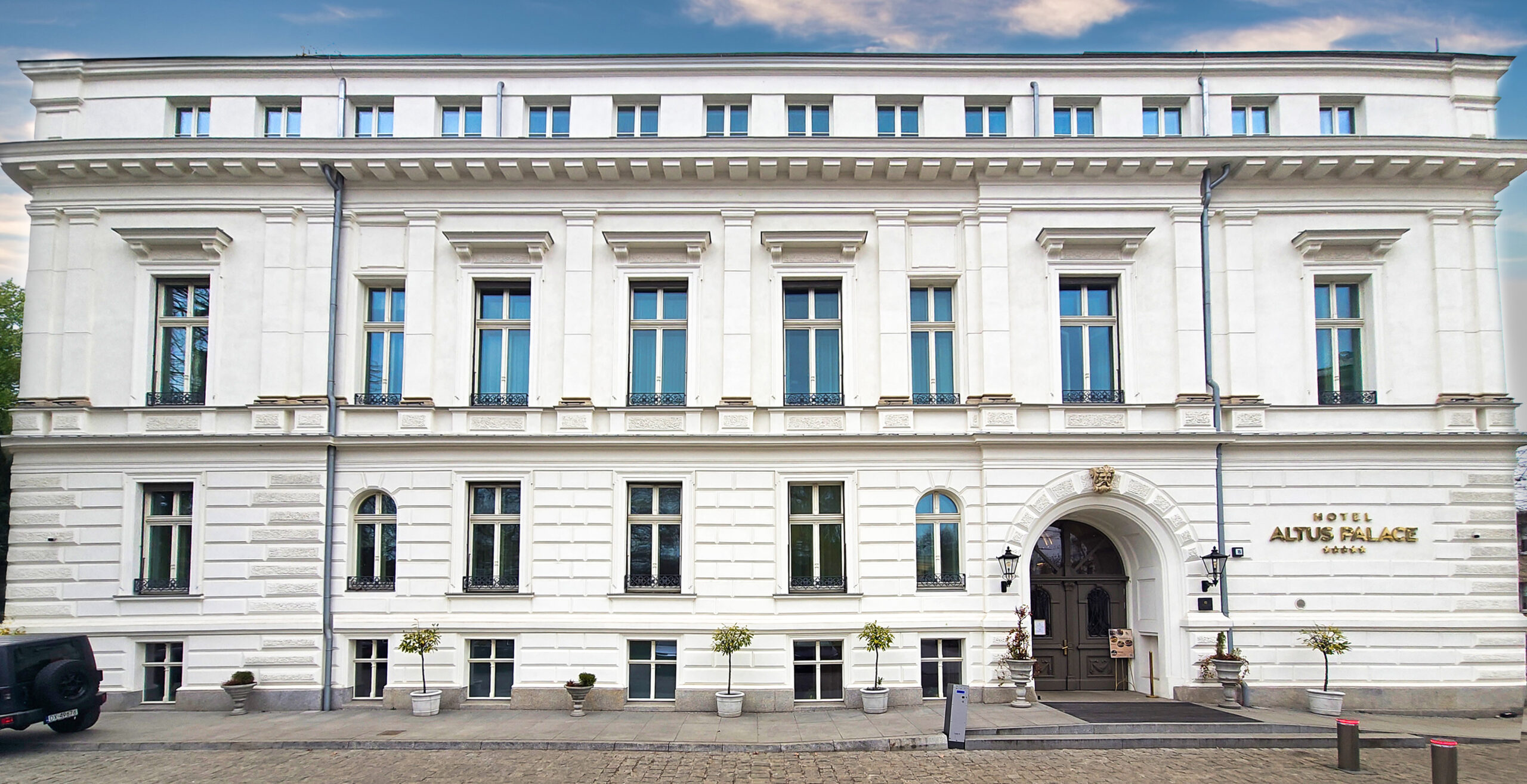
In the immediate vicinity of the square, you’ll also find several important buildings—including a modern spa center housed in the former municipal bathhouse, as well as numerous Art Nouveau and modernist tenement houses that form a scenic backdrop for the area.
Particular attention should be paid to the sandy-colored building of the former municipal bathhouse, which holds over 120 years of history. Built in 1897 and designed by Wilhelm Werdelmann, the facility originally offered a swimming pool, steam baths, and hygienic bathing options. It was the first institution of its kind in the city and continues to serve residents today as a place for relaxation and wellness.
Continuing your walk through the greenery and historic architecture, you’ll come upon a stately, aristocratic residence—the Leipziger Palace. At first glance, the building radiates elegance and dignity. Erected between 1874 and 1876, the palace was a luxurious residence for the Leipziger family—prominent bankers and industrialists who were part of Wrocław’s elite at the time. The grand structure was built in the spirit of historicism, with clear influences of Neo-Renaissance and Classicism. The building’s façade impresses with its timeless beauty, rich stucco work, and refined architectural details. Today, the palace houses a luxury hotel.
The Sakwowy Bastion, also known as Wzgórze Partyzantów (Partisans' Hill), is a unique and historically rich site in Wrocław. Its origins date back to the 13th century, when the city began expanding its fortifications in response to Mongol invasions. At that time, the Sakwowa Gate was built, later transformed into a bastion that, from the 17th century, played a key defensive role.
After the city walls were demolished in 1807 by order of the French occupiers, the area was converted into a recreational hill known as Wzgórze Sakwowe. In 1867, with the construction of a belvedere and a viewing tower, it was renamed Liebichs Höhe (Liebich’s Hill). During the Siege of Wrocław in 1945, the site was once again used for military purposes—the casemates served as shelters, and the tower of the gloriette was destroyed to prevent it from becoming an artillery target.
After the war, the site was renamed Wzgórze Partyzantów, but for decades it fell into disrepair. Today, following a completed revitalization in 2024, the Sakwowy Bastion has regained its former splendor—with a restored colonnade, fountain, staircase, and café. This historic place has once again become a favorite spot for gatherings, walks, and relaxation—a true symbol of the renewed life of Wrocław’s historic corners.
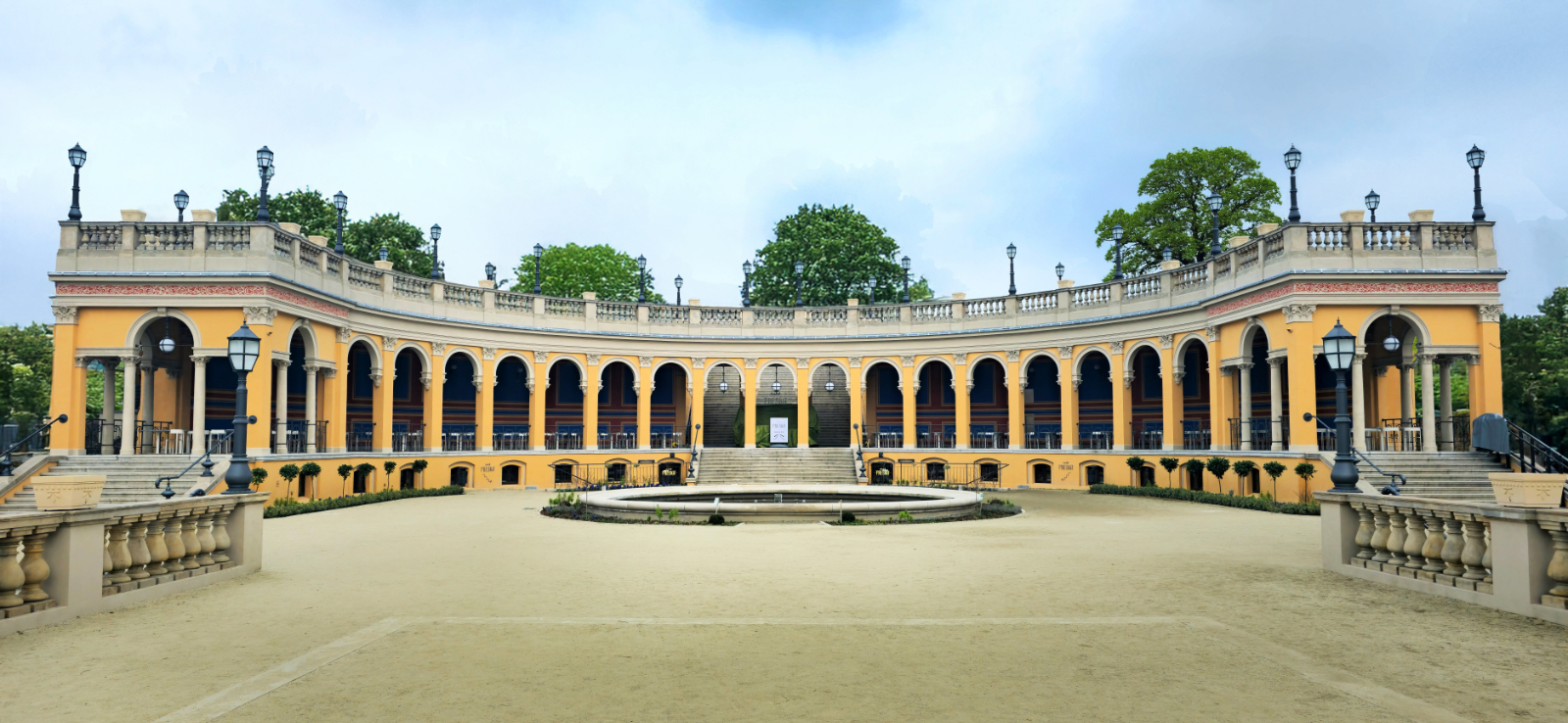
Amid theaters, historic hotels, and elegant townhouses, the Świdnickie Suburb (Przejście Świdnickie) hides a variety of restaurants, cafés, and bars that give this part of Wrocław its unique charm. While exploring the area, it’s worth pausing for a moment to relax in one of the local cafés or restaurants—an ideal opportunity to recharge while savoring both the flavors and atmosphere.
Mövenpick Café – Swiss Elegance by Wrocław’s Main Station
This is the only Mövenpick café in Poland, making it a distinctive spot on Wrocław’s culinary map. The menu features top-quality products—aromatic coffee, freshly baked cakes, classic Mövenpick ice cream desserts, and carefully selected snacks. The interior of the café blends elegance with coziness, thoughtfully referencing the historic character of the building.
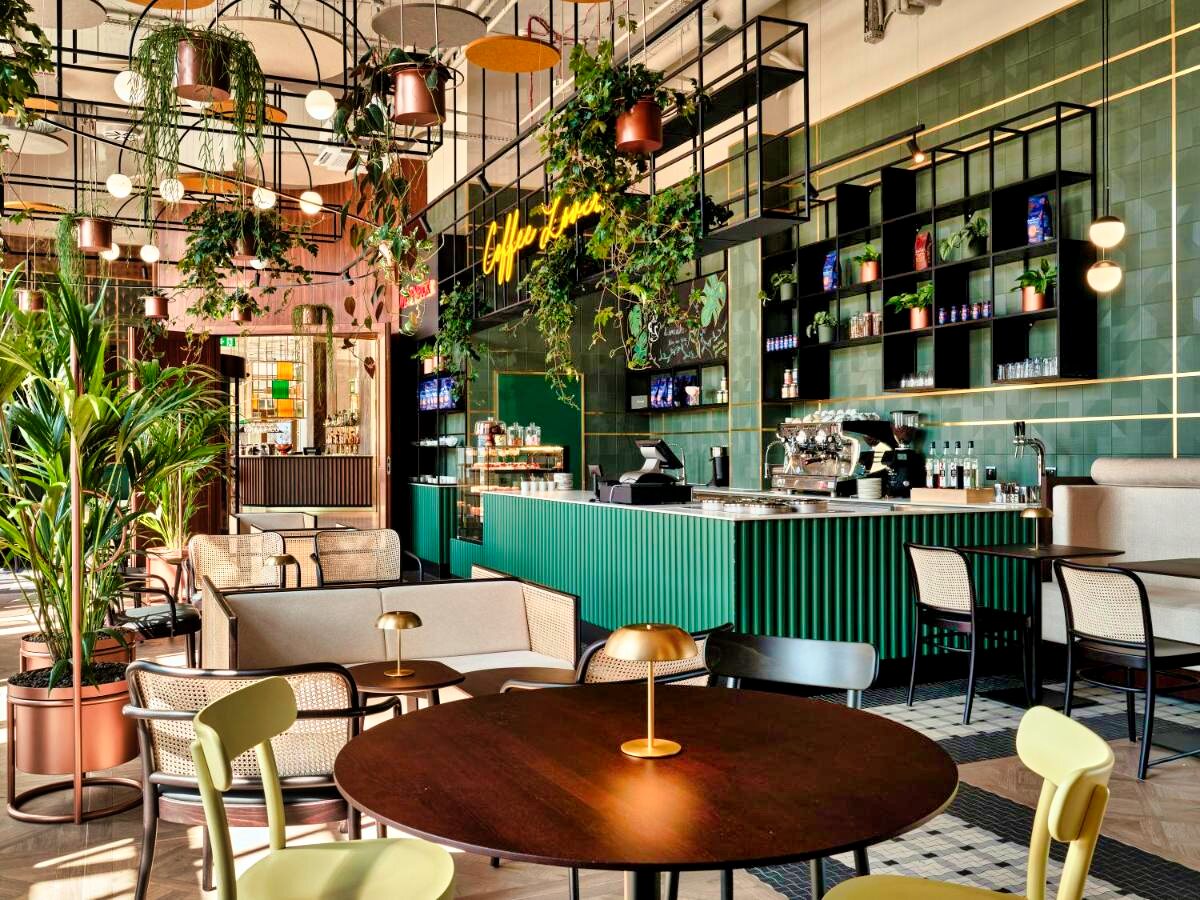
The Gate Restaurant – Modern Cuisine in the Historic Heart of the City
The Gate Restaurant, whose name symbolically refers to the "gateway to Wrocław," welcomes guests into its elegant interiors within the beautifully restored historic Grand Hotel. High ceilings, large windows, and natural light highlight the classic details and noble materials—wood, marble, and brass—creating a refined yet comfortable atmosphere.
The dishes served are culinary compositions perfected in every detail—delighting both in flavor and visual presentation. The menu offers a signature take on European and Polish cuisine, crafted from seasonal, locally sourced ingredients. From sophisticated starters and exquisite main courses to elegant desserts, every element tells a cohesive, flavorful story. The experience is completed by a carefully curated wine list and professional service.

Waikiki Bistro
Waikiki Bistro is a fresh addition to Wrocław’s culinary scene, located just next to the Main Railway Station and adjacent to the historic Hotel Piast. From the very first moment, it welcomes guests with a relaxed, summery vibe inspired by the spirit of the Hawaiian Islands. The interior delights with its lightness and color—tropical plants, natural materials, and exotic details create a space perfect for unwinding and carefree gatherings.
The menu is based on fresh ingredients and simplicity—featuring signature poke bowls in a variety of combinations, blending vegetables, fish, meats, and bold toppings into balanced culinary creations. Every dish looks as delicious as it tastes—light, colorful, and full of vacation energy.
Waikiki Bistro is the perfect spot for anyone seeking a taste of the exotic in the heart of the city—a place to slow down and savor the moment, whether during a travel break or a meetup with friends.
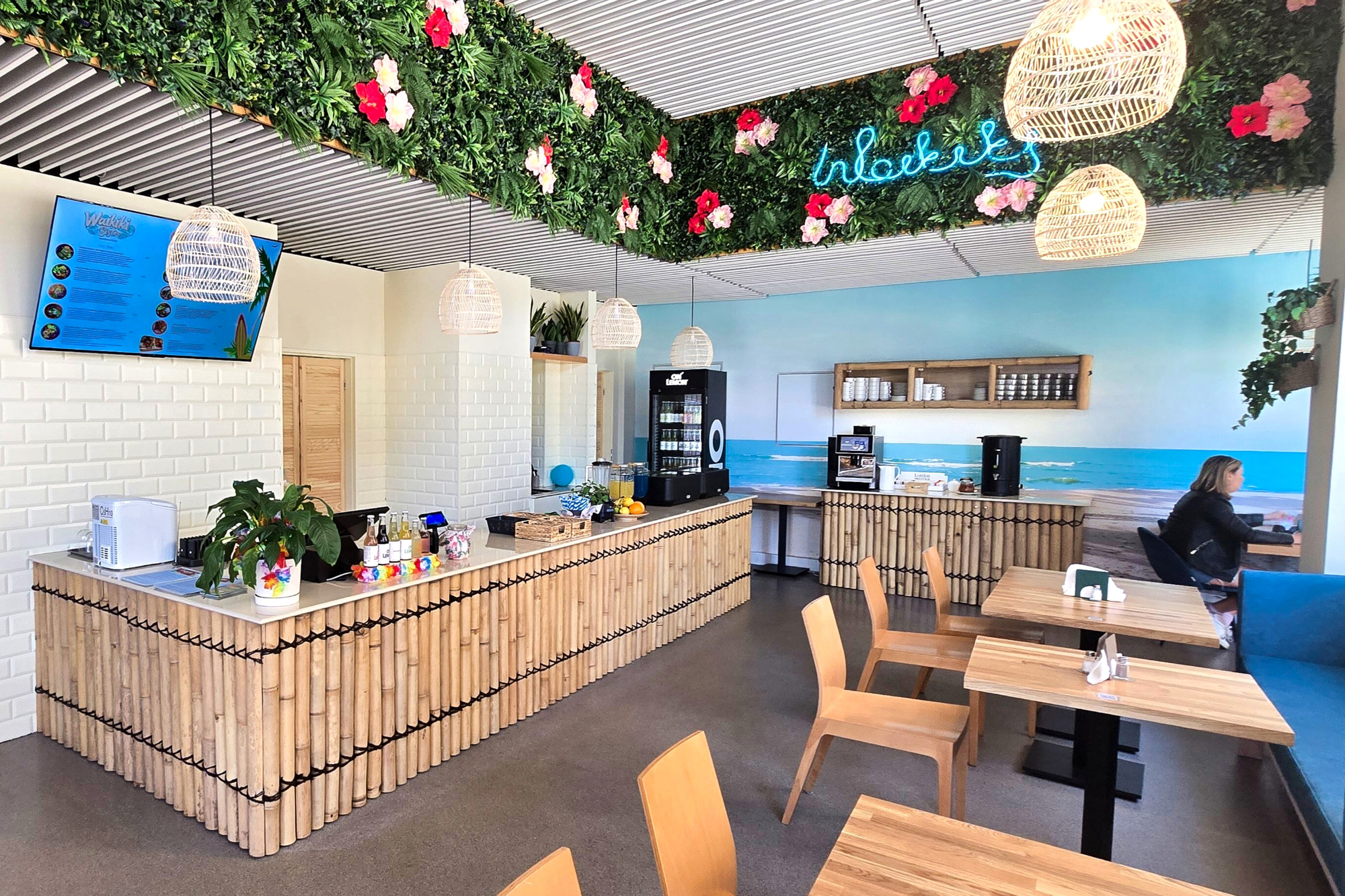
LUCA Bakery – Freshly Baked Romanian Delights
LUCA Bakery is a Romanian bakery chain offering a unique selection of signature bagels, fresh sandwiches, pizza by the slice, sweet pastries, and artisanal ZMEU coffee. The products stand out for their high quality, exceptional taste, and are baked fresh on-site.
Kawiarnia Europejska – A Stylish Café with a Rich History
Located within the historic Hotel Europejski, Kawiarnia Europejska blends pre-war elegance with an intimate atmosphere. Its Viennese-style interior enchants with a harmonious palette of white, warm beige, red, and gold. Elegance is further enhanced by the marble flooring and tabletops, as well as the counter, all crafted from the same refined stone.
A special highlight of the café is its illuminated stained-glass ceiling panels, featuring sun motifs and whimsical floral designs—adding a unique charm and artistic flair to the space. Stylish details, tall windows, and plush armchairs create the perfect setting for conversations over a cup of coffee.
The menu features aromatic coffees, loose-leaf teas, and homemade pastries prepared according to traditional recipes. The classic W-Z cake and the fluffy cheesecake are particularly worth trying. It’s an ideal place for social gatherings, a relaxing break, or a peaceful morning with coffee.
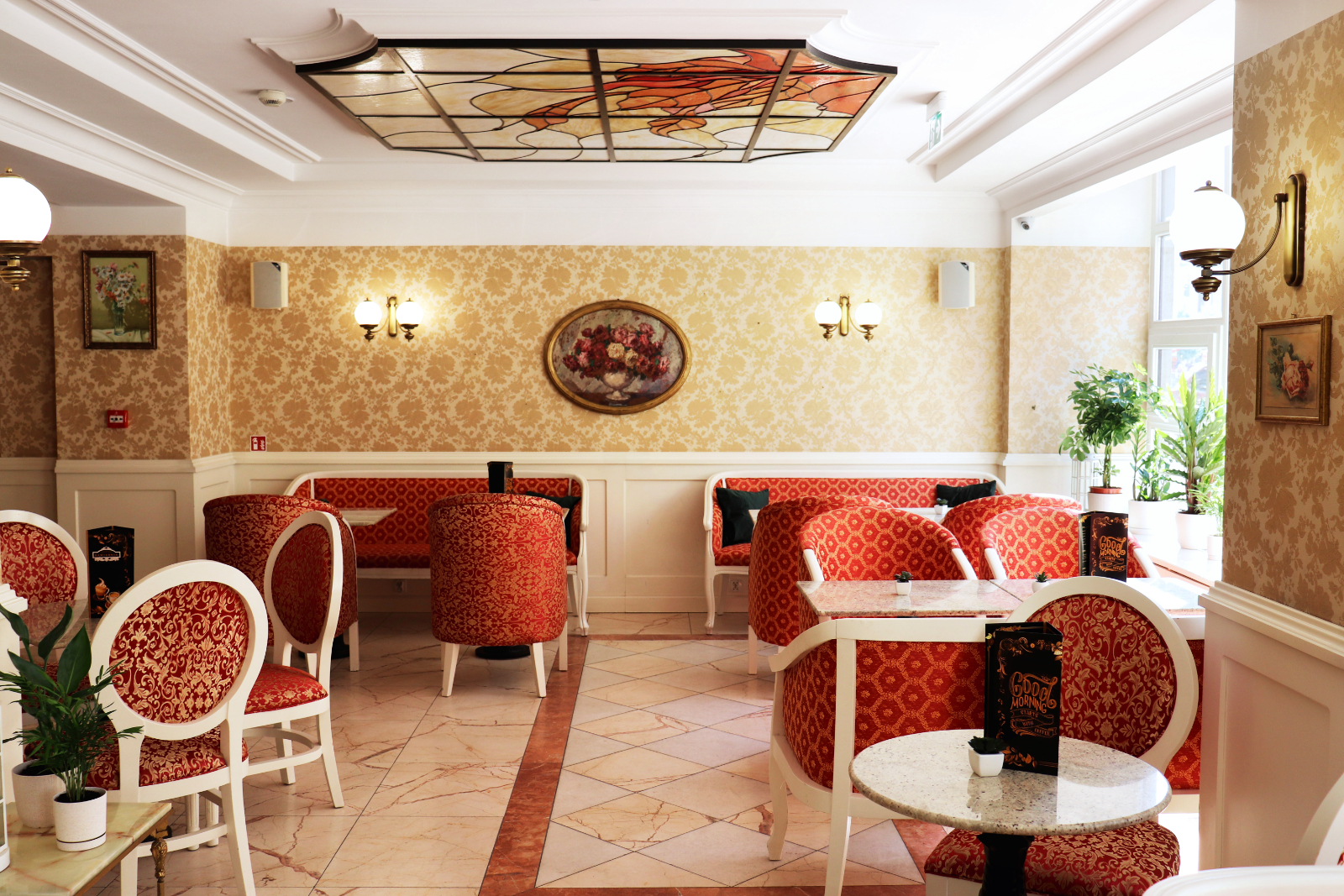
Galicja Restaurant – The Taste of Tradition in a Historic Setting
Located next to Hotel Polonia, Galicja Restaurant is a place where traditional Polish cuisine meets the spirit of old Galicia. The stylish interior, inspired by the Austro-Hungarian monarchy of the late 19th and early 20th centuries, enchants with its wooden finishes, tasteful furnishings, and wall decorations that evoke the atmosphere of a bygone era. Portraits of Empress Sisi and Emperor Franz I transport guests to the glory days of Galician heritage.
The menu features classic Polish flavors with a modern twist, enriched by influences from Galician cuisine. Among the most popular dishes are the aromatic broth with dumplings and goose-filled pierogi—impressive not only in flavor but also in their elegant presentation.
Galicja Restaurant is a place where the taste of tradition meets elegance and attention to every detail. It’s the perfect setting for a family lunch, a romantic candlelit dinner, or a gathering with friends.
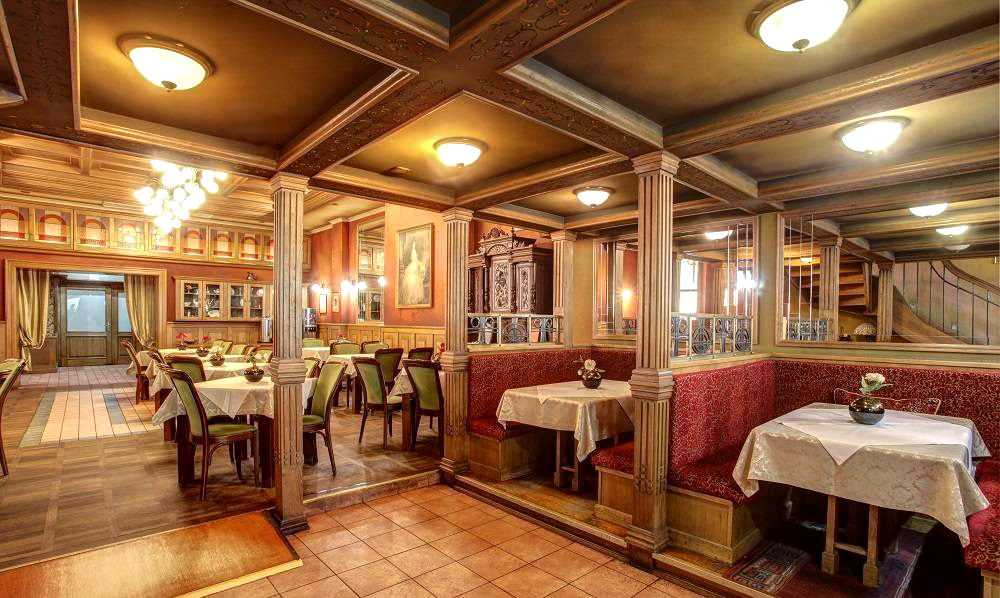
Samarqand Restaurant – The Taste of Uzbekistan in the Heart of the City
Samarqand Restaurant on Stawowa Street is a unique spot that takes guests on a culinary journey to the heart of Central Asia. A richness of spices, bold flavors, and authentic Uzbek hospitality come together to create an unforgettable experience.
The menu, inspired by traditional Uzbek cuisine, features a variety of aromatic dishes—from handmade dumplings and slow-cooked meats to meals infused with the scents of cumin, coriander, and fresh herbs.
The interior delights with its warm, colorful atmosphere, enhanced by details that reflect oriental architecture—transporting guests into a world of tradition, flavor, and Central Asian hospitality.
After an intense day of exploring the city, it’s worth taking a break to relax and enjoy the pleasure of shopping. In the area around the Świdnickie Suburb (Przedmieście Świdnickie), you’ll find elegant shopping galleries and exclusive boutiques featuring renowned brands. Just a few steps from the historic Main Railway Station—on the opposite side—you’ll discover a unique place: Wroclavia.
To get there, simply pass through the station’s historic hall—where it’s well worth pausing to admire the beautiful vaulted ceilings, wooden counters, and meticulously restored architectural details—before stepping into a modern world of fashion, flavor, and entertainment.
Wroclavia is one of the most modern shopping centers in Poland and has quickly gained popularity among both locals and tourists visiting Wrocław. It features over 180 stores from well-known brands, stylish restaurants, cafés, and a variety of entertainment options, including a state-of-the-art IMAX cinema.
The center’s contemporary architecture is also noteworthy—with glass entrances, bright and spacious interiors, and green terraces that create a welcoming space for relaxation and social gatherings.
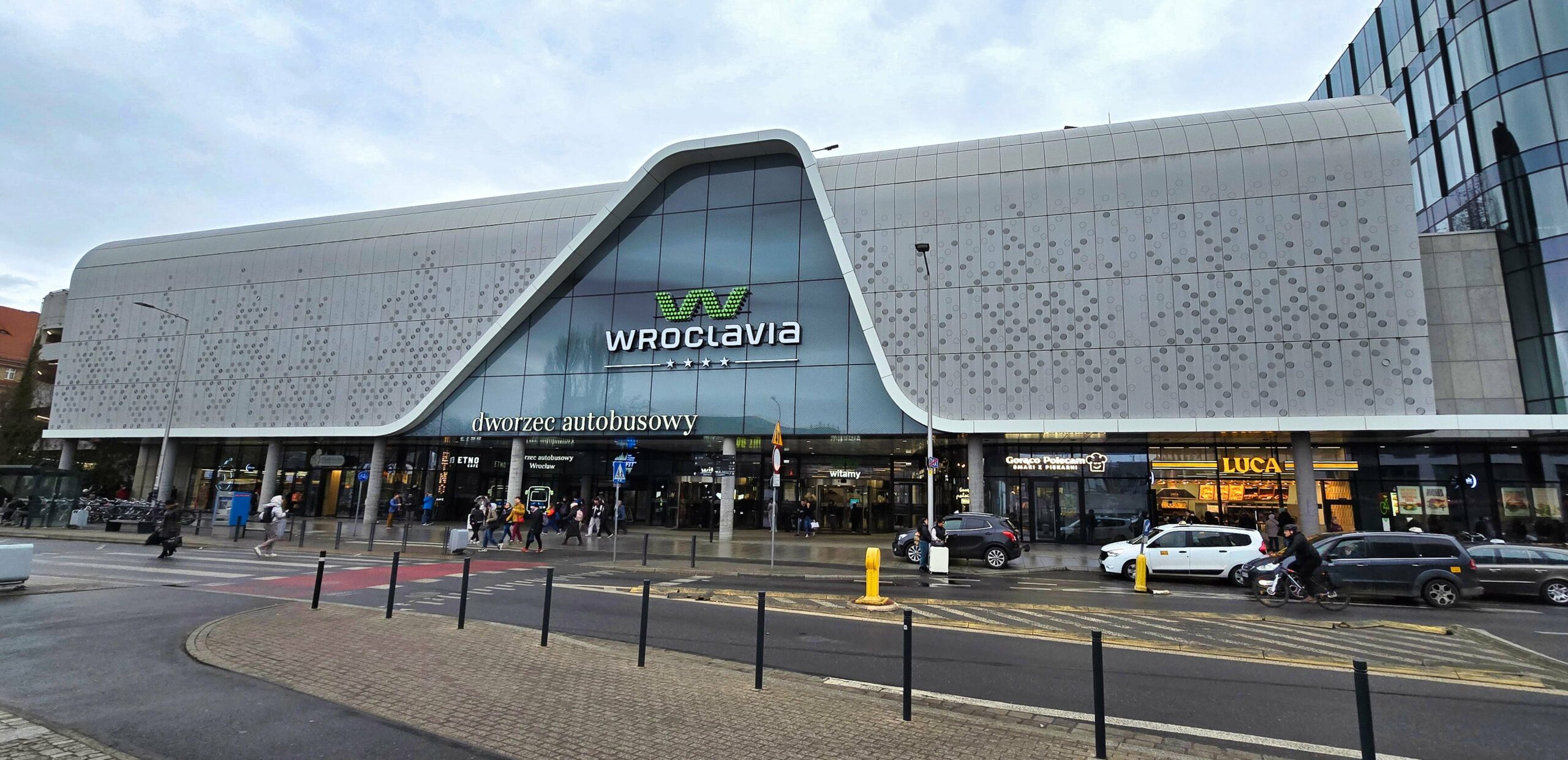
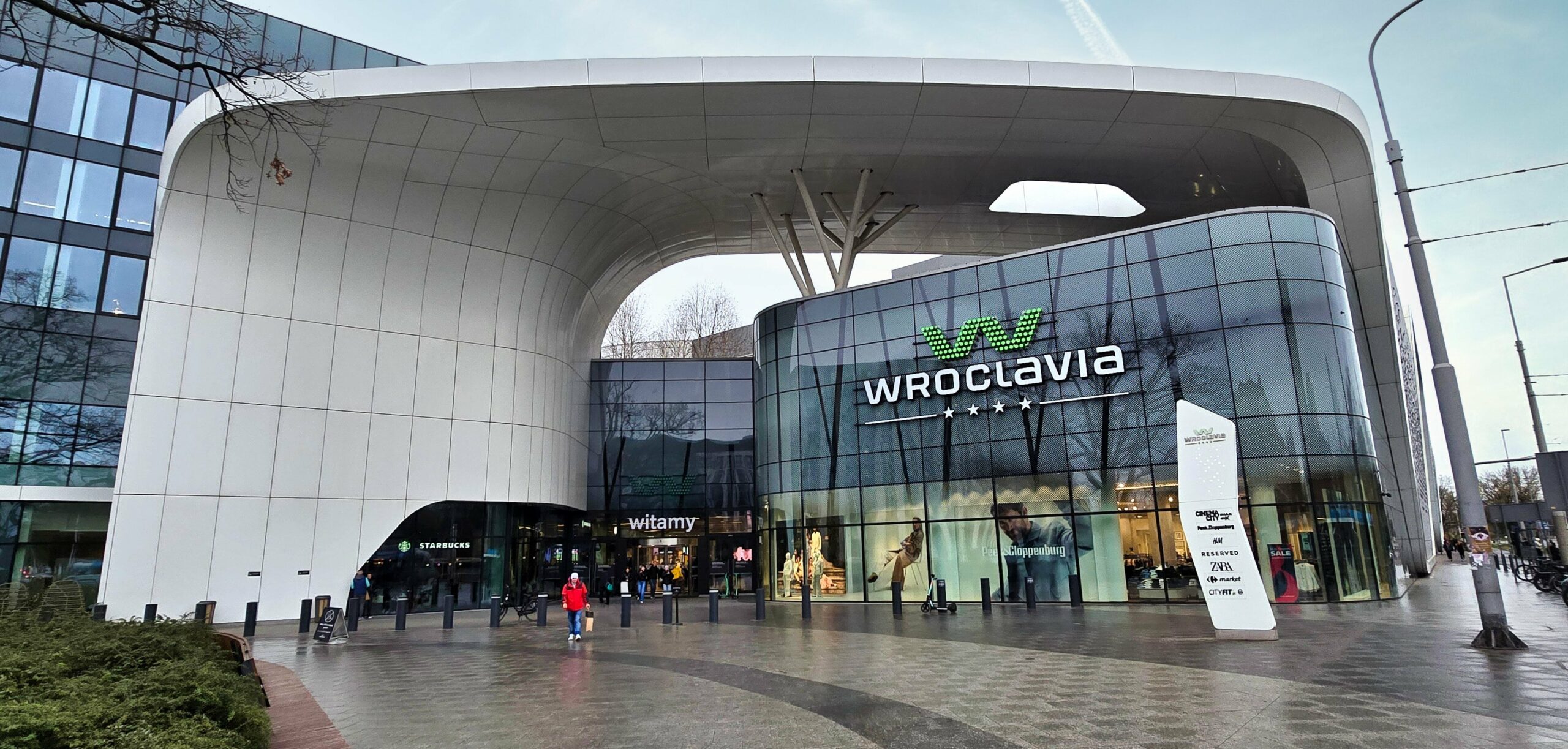
Just behind the Capitol Musical Theatre, running parallel to Piłsudskiego Street, lies Bogusławskiego Street—a unique part of the city that is calm and quiet by day, but full of life at night. Locals know it as “Pod Nasypem” (Under the Embankment)—an authentic, artistic, and non-commercial alternative to the touristy Market Square.
This distinctive space was brought to life by local entrepreneurs who saw potential in the unused arches beneath the railway tracks leading to the Main Railway Station. Within these raw, industrial spaces, they created cozy restaurants and pubs with soul—each with its own unique character, cuisine, and atmosphere.
“Pod Nasypem” is the essence of Wrocław’s spirit—unhurried, creative, and genuine. It’s worth stopping by, settling into one of the local spots, and simply soaking in the rhythm of the city.




